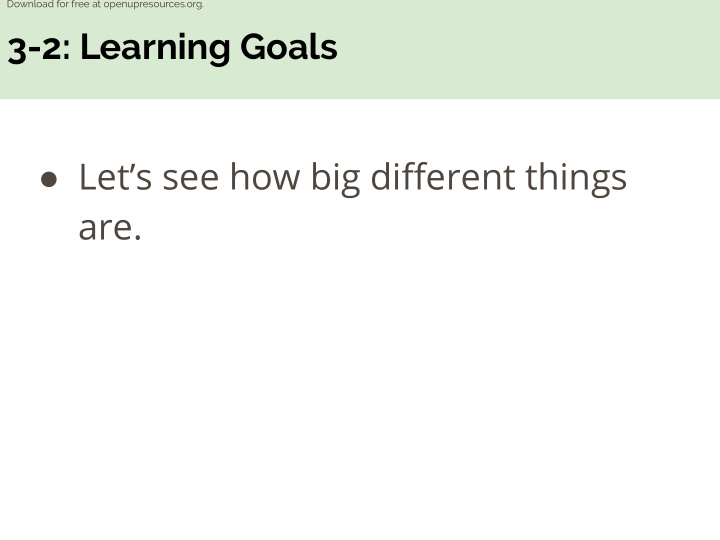



Download for free at openupresources.org. 3-2: Learning Goals ● Let’s see how big different things are.
Download for free at openupresources.org. 3-2-1: Estimating Volume
Download for free at openupresources.org. 3-2-2: Cutting String Your teacher will assign you one of the following lengths: 1 centimeter, 1 foot, 1 inch, 1 meter, or 1 yard. Estimate and cut a piece of string as close to your assigned length as you can without using a measurement tool.
Download for free at openupresources.org. 3-2-3: Card Sort: Measurements Your teacher will give you some cards with the names of different units of measurement and other cards with pictures of objects. 1. Sort the units of measurement into groups based on the attribute they measure. Pause here so your teacher can review your groups. 2. Match each picture card that has “L” in the top right corner with the closest unit to the length of the object. 3. Match each picture card that has “V” in the top right corner with the closest unit to the volume of the object. 4. Match each picture card that has “WM” in the top right corner with the closest unit to the weight or mass of the object. Your teacher will assign you a new group to discuss how you matched the objects. If you disagree, work to reach an agreement.
Download for free at openupresources.org. 3-2: Lesson Synthesis
Download for free at openupresources.org. 3-2: Learning Targets ● When I read or hear a unit of measurement, I know whether it is used to measure length, weight, or volume. ● I can name common objects that are about as long as 1 inch, foot, yard, mile, millimeter, centimeter, meter, or kilometer. ● I can name common objects that weigh about 1 ounce, pound, ton, gram, or kilogram, or that hold about 1 cup, quart, gallon, milliliter, or liter.
Download for free at openupresources.org. 3-2-4: So Much in Common Lin and Elena have discovered they have so much in common. 1. They each walk 500 units to school. Who walks 500 feet, and who walks 500 yards? Explain your reasoning. 2. They each have a fish tank holding 20 units of water. Whose tank holds 20 gallons, and whose holds 20 cups? Explain your reasoning. 3. They each have a brother who weighs 40 units. Whose brother weighs 40 pounds, and whose weighs 40 kilograms? Explain your reasoning.
Recommend
More recommend